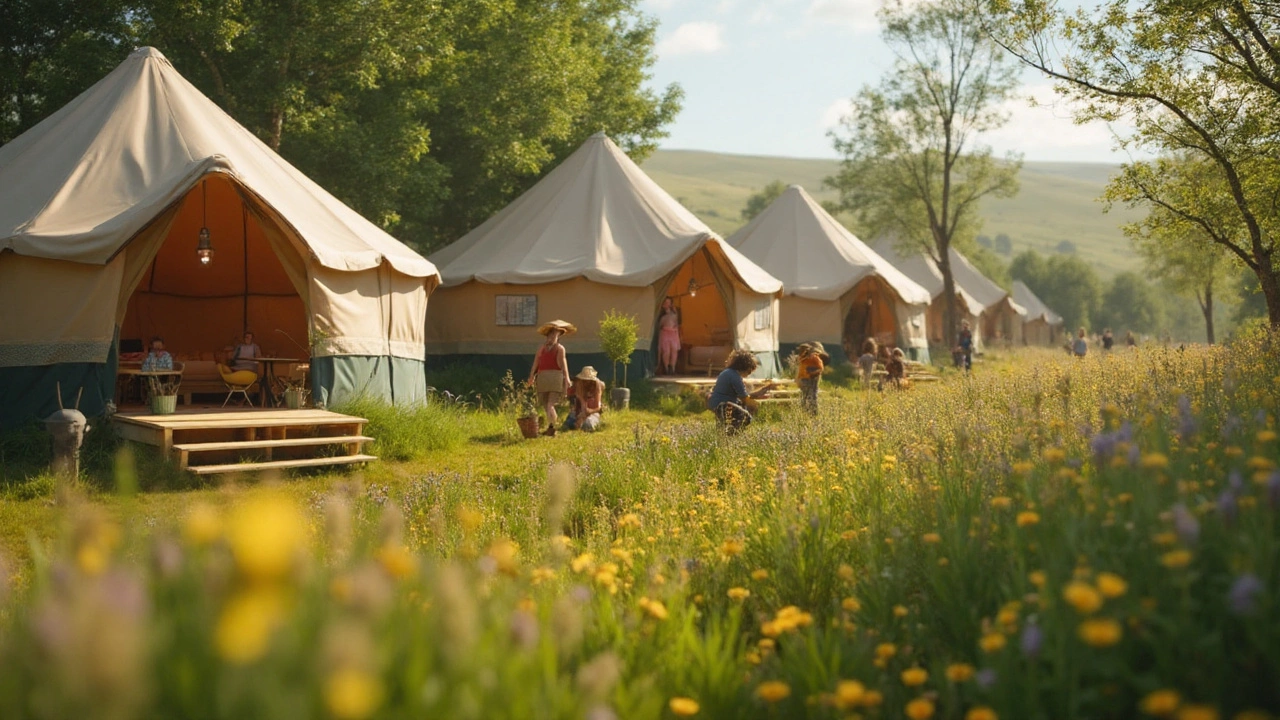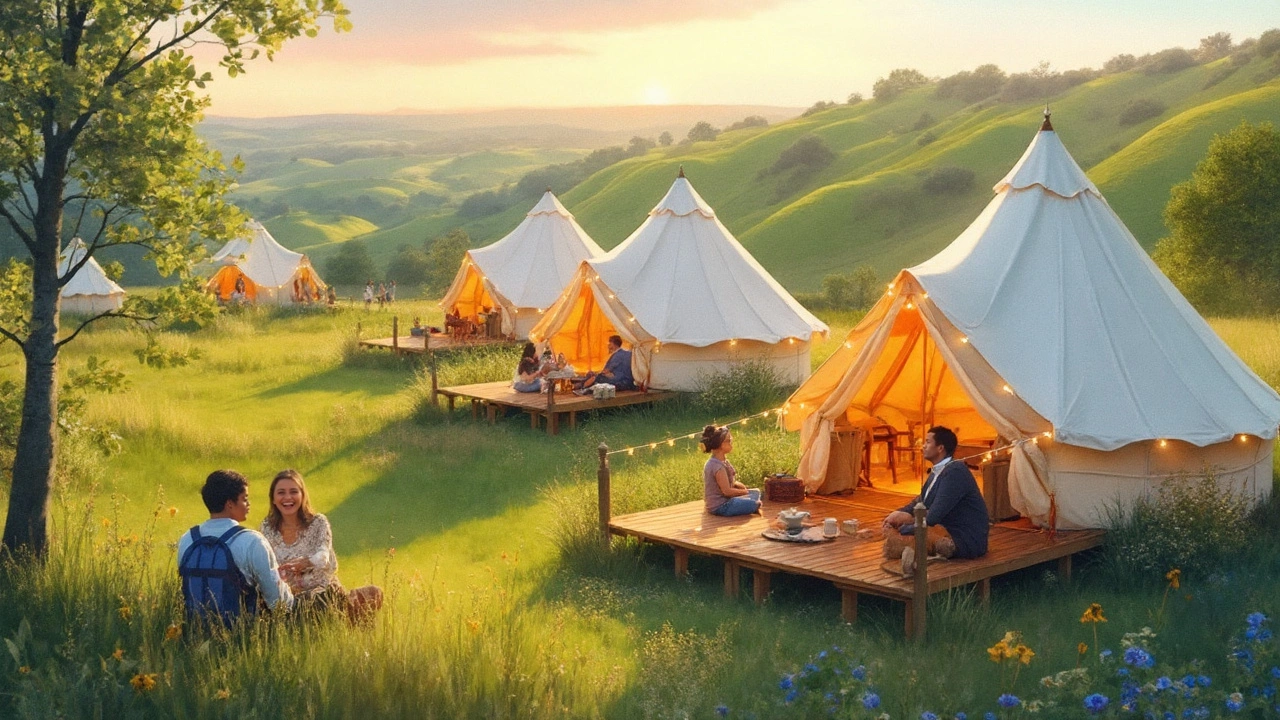Fancy bell tents in wildflower meadows, treehouses with solar lights, hot showers under the stars—glamping is everywhere, popping up on rural farms and even city rooftops. But some people wonder: is this Instagram-ready camping just another trendy way to pollute delicately balanced landscapes, or can glamping actually help the environment? Turns out, when done right, glamping can be surprisingly eco-friendly. Let’s peek behind the canvas and find out how glamping is changing the way we travel green.
The Roots of Eco-Friendly Glamping
The origin of glamping goes back farther than you’d think. Long before the word hit travel blogs, indigenous communities set up tents, yurts, and huts with almost zero environmental impact—everything got reused, recycled, or returned to the earth. Modern glamping borrows these ancient techniques and layers in some clever twenty-first century twists. Instead of synthetic tents and disposable gear, many glampsites use locally sourced wood, canvas, or upcycled shipping containers for their cabins and pods. Some even run totally off-grid, powered by sun, wind, or micro-hydro streams.
Where standard camping can leave a site trampled and trashed, many glampsites pay special attention to their land. Luxury eco-pods get tucked on raised wooden stilts, protecting roots and wildflowers underneath. Wastewater from showers and sinks can be filtered naturally through beds of reeds—a trick borrowed from permaculture. You’ll spot compost toilets, rainwater barrels, and even living roofs bursting with bees and butterflies. It’s not just a gimmick: a 2023 UK study found that over 60% of eco-glampsites had cut their waste output in half by switching to low-impact design.
Living mostly outside means more time connecting with nature. The fewer screens around, the more your senses pick up the small details—a red kite soaring overhead, a fox darting at dusk—which end up building a deeper respect for wild places. Hosts often run programs for replanting trees, maintaining bee hives, or teaching foraging and bird ID. Guests leave a little more eco-savvy, and the land ends up better cared for than it was before.
Many glampsites support local wildlife rather than scaring it off. By using native plants in landscaping and limiting artificial lighting, sites invite bats, owls, insects, and hedgehogs. Nature corridors get preserved rather than fenced off, so the creatures who lived there before keep right on thriving.
How Glamping Reduces Carbon Footprints
Everyone talks about "carbon footprints” now, but glamping really does have a shot at shrinking them. Traditional hotels use loads of energy—think air conditioning for hallways, giant laundries, and enormous water use. Glamping crosses out many of these high-impact practices. Fewer lights and gadgets mean less power demand. Solar fairy lights and wood-fired stoves replace thirsty heaters and floodlights. One 2022 survey in Sweden found that remote glamping sites used just a third of the electricity per guest compared to city hotels.
Transportation is another piece of this puzzle. You don’t need to fly or drive to the other side of the world to find a unique stay—so more people are trying local or regional getaways. There’s also the trend of “leave no trace” travel. The best glampsites make it clear: pack out your rubbish, stick to the paths, and respect the land. By keeping numbers small, eco-glampsites prevent wear and tear on delicate spots.
But the biggest shift is in onsite decision-making. Glampers are more likely to eat local food—sometimes grown right on site—or buy from nearby farms and artisans. Fewer imported snacks and no mini bars stuffed with plastic bottles; instead, it’s local bread, cheese, and seasonal veggies. In Wales, one rural glampsite claimed its average guest spent £40 per night at local markets—money that stays in the community, supporting sustainable agriculture too. None of this is about sacrifice; it’s swapping anonymous hotel experiences for something tastier and more authentic.
Don’t forget water usage. Many glampsites rely on filtered rainwater, composting toilets, and clever greywater systems, which means less strain on local resources, even during peak summer. Tiny home-style glamping pods usually come with serious encouragement to save energy and water. A study in Italy (2023) showed glampsite guests used only 60% as much water per night as hotel-goers in the same region.

Creative Eco-Friendly Glamping Ideas
Glamping gets interesting when you peek at the creative ways hosts blend luxury and sustainability. Some places offer off-grid solar-powered showers you can heat up yourself (with a bit of effort—but hey, you're a glamper, right?). Others have wood-fired hot tubs made from recycled whisky barrels, kept warm by local deadfall timber. Want to sleep in a hobbit house buried into a green hillside? Those turf roofs double as natural insulation, cutting heating needs by almost 90% compared to a typical cabin.
Some glampsites upcycle furniture and fixtures you’d never expect. Antique tin baths become garden planters; reclaimed scaffolding turns into bunk beds. Rain collection systems feed kitchen sinks and flowers. If you’re hunting for glamping that truly walks the eco-walk, keep an eye out for sites with these features:
- Biosolar roofs planted with wildflowers or sedum
- Reusable, natural fiber linens and organic biodegradable toiletries
- Onsite composting and food waste collection
- Low-impact bush trails and wooden walkways
- No-waste dining: reusable plates and glassware, bulk refills for coffee, tea, and soap
- Local-grown wildflower seed giveaways or tree planting programs
Want practical tips for more eco-friendly glamping on your next escape? Here’s what makes the biggest difference:
- Bring your own zero-waste kit: bamboo cutlery, reusable cups and water bottle, cloth napkin
- Pick glampsites with visible eco-certifications—Green Key, EcoTourism International, or local equivalents
- Travel lighter and support green transport—bring a bike or take a shared transfer if offered
- Stick to the marked trails and pitch in with any onsite environmental projects
- Opt for sites that pledge to avoid single-use plastics and fossil fuel energy sources
- Buy meals and souvenirs directly from local producers
- Conserve water and energy—shorter showers, unplug gadgets when not in use
Families with kids? A lot of glamping hosts run workshops teaching about pollinators, wild foods, or animal tracking. These hands-on sessions spark real excitement for sustainable living, way more than any eco-lecture you’ll hear in a classroom.
The Real Impact: Community, Wildlife, and Mindset Shifts
One thing glamping gets right: it’s not just about the immediate footprint, but about shifting the whole approach to travel. Instead of ticking destinations off a list, people slow down and actually notice their surroundings. This slow travel mindset means longer stays, deeper connections with hosts and other guests, and less polluting travel back-and-forth. In 2024, a Canada-based glamping chain found repeat guests spent 50% more time at their sites than those at chain hotels, reporting lower stress and higher satisfaction on follow-ups.
Communities in rural spots aren’t bypassed—they’re put front and center. Glamping bolsters farmers, crafters, and guides who might otherwise be cut out of the tourism economy. When glampsites hire locally, source materials in the neighborhood, and share profits with community projects, everyone wins. Some sites even let guests help out: harvest herbs, mend fencing, or muck in for habitat restoration days. These aren’t PR stunts. When hands get dirty and conversations flow, guests stop seeing green travel as a chore and start seeing it as joy.
And wildlife? Sites that follow "wildlife first" principles—turning off lights at night, refusing pesticides, and keeping natural hedgerows—find their lands fill with birds, insects, and small mammals. By working with conservation groups, some glamping hosts restore habitats, protect rare species, or even open up new walking trails that don’t disturb fragile breeding grounds. Guests end up as accidental nature guardians, sharing sightings with scientists or donating to local causes.
At its best, glamping isn’t just a comfy escape from the city. It’s a small rebellion against throwaway travel, proof that luxury can be low impact, and a real step toward a lighter tread on the earth. Next time you're browsing glampsites, look for the ones that tout more than just style—seek out genuine, measurable commitment to stewardship, and you’ll sleep even sounder under the stars. With each eco-stay, we nudge the needle toward a greener, more mindful tourism—one cozy night and crackling log fire at a time. Eco-friendly glamping really does walk the walk, not just talk the talk, when you know what to look for and how to join in.
